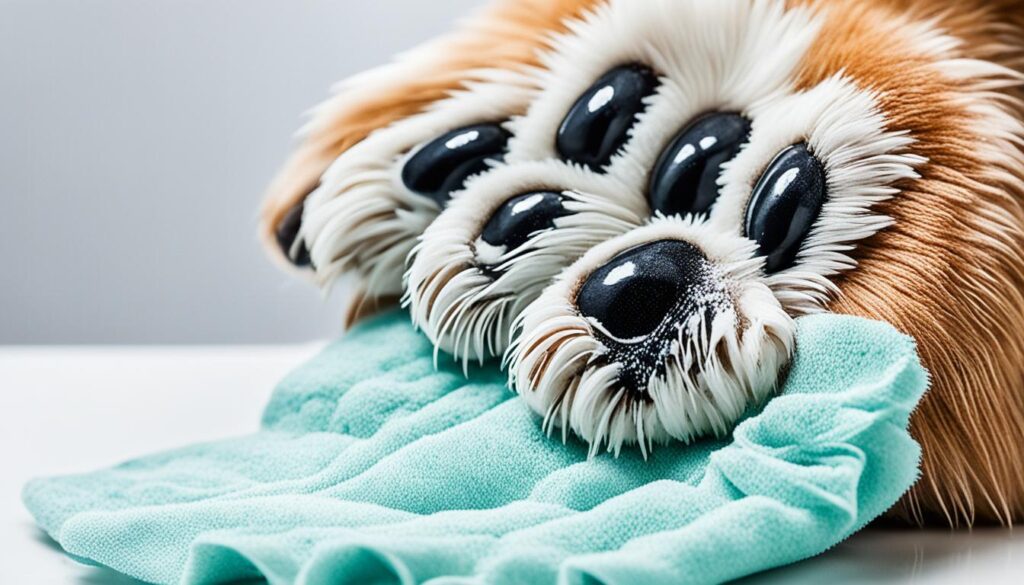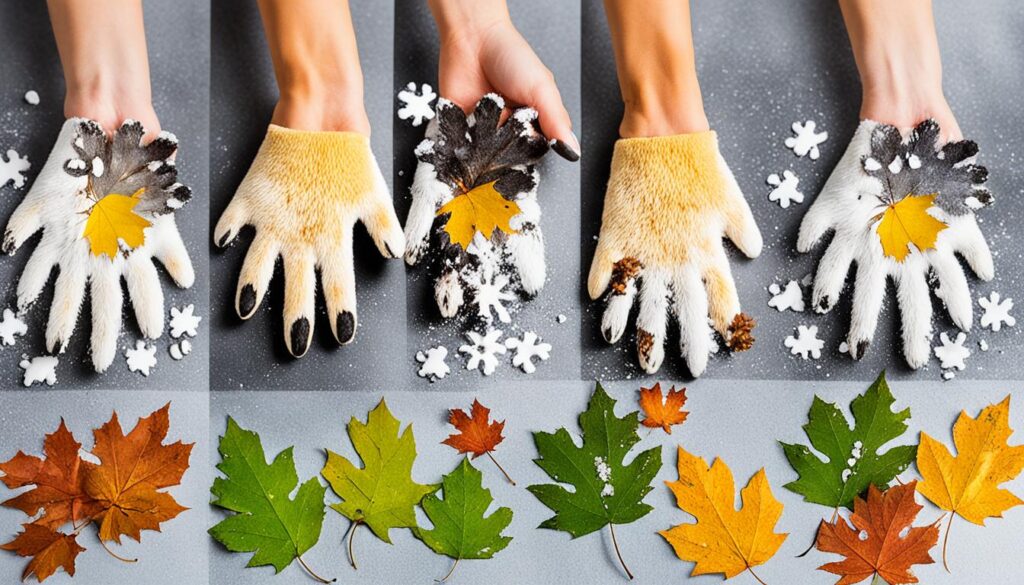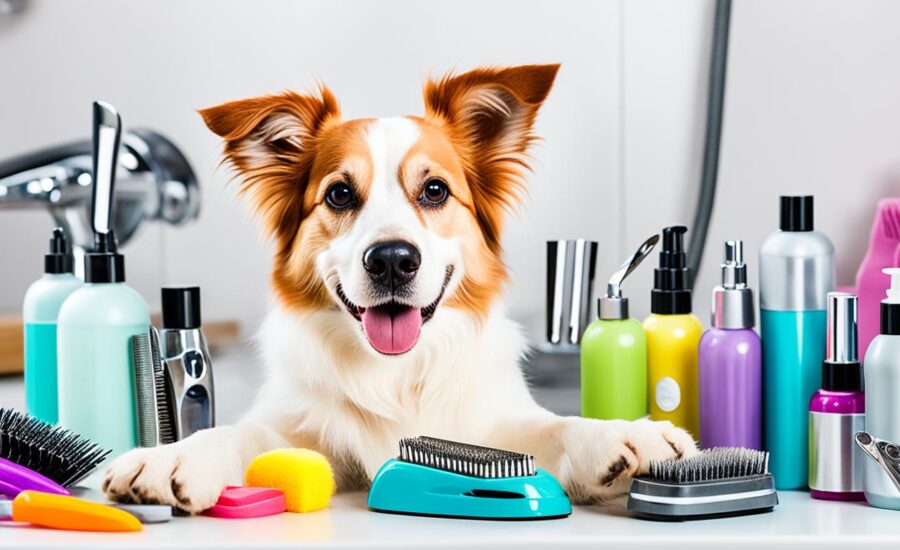Pets fill our lives with joy, love, and friendship. But, do we care for their paws as we should? They walk barefoot on different surfaces every day. Have you thought about what could stick between their toes or pad?
From sharp autumn leaves to hot summer asphalt, their paws tackle many challenges. Learning and using pet paw grooming tips can prevent pain and ensure a happy walk. It’s about more than cleanliness; it’s about their health and joy.
Grooming your pet’s paws isn’t just for looks. It helps prevent problems that could keep them from playing. Like we don’t enter our homes with dirty shoes or risk our feet, pets need care for their pet paw hygiene. With regular nail cuts and soothing balms, we can make their steps pain-free.
Key Takeaways
- Understanding why regular pet paw grooming tips are vital for your pet’s comfort and health
- Implementing simple practices in pet paw care to prevent issues and enhance hygiene
- Techniques and benefits of grooming your pet’s paws, including nail clipping and hair trimming
- Maintaining pet paw hygiene through cleaning and the application of protective balms
- Encouraging pet owners to develop a paw-care routine to match the proactive measures of seasoned groomers
Understanding the Importance of Pet Paw Care
The health of our pets is closely linked to paw health for pets. Their paws aren’t just cute; they’re essential for daily life. It’s important to keep their paws healthy, not just for looks but for their quality of life. Pets use their paws for everything, whether they’re walking on sidewalks or playing in fields. So, taking good care of their paws is key to their overall health.
The Vital Role of Paws in Pet Health
The condition of a pet’s paws tells us a lot about their health. Paws protect their bones and joints and help with movement. They also have sweat glands that keep them cool and improve grip. Healthy paws mean a happy, active pet.
Common Issues Affecting Paw Health for Pets
Many things can harm paw health for pets. This includes road salt, hot concrete, and ice. Problems like infections, bugs, and injuries can also hurt them. Being proactive in caring for your pet’s paws helps avoid these issues.
Initial Signs of Paw Problems to Watch For
To prevent damage, watch for early signs of trouble. This includes limping, paw licking, redness, swelling, and not wanting to walk. Checking their paws often can help catch problems early. This means you can get them the help they need quickly.
| Common Paw Problems | Symptoms | Preventative Tips |
|---|---|---|
| Cuts and Abrasions | Limping, Bleeding | Inspect paws post-walk, avoid hazardous terrain |
| Burns from Hot Pavement | Refusal to Walk, Paw Licking | Walk during cooler hours, use protective booties |
| Frostbite/Ice Damage | Discoloration, Brittleness | Limit exposure to cold, apply paw balm regularly |
| Allergic Reactions | Swelling, Redness | Rinse paws after outdoor activities, monitor for allergens |
Having a routine for paw health for pets can prevent a lot of problems. By caring for your pet’s paws, you help them live a happy, healthy life. Caring for their paws lets pets enjoy every adventure comfortably and joyfully.
Grooming Your Pet’s Paws: Keeping Them Healthy and Clean
Caring for your pet’s paws is important for comfort and health. This includes regular cleaning and trimming to prevent discomfort or infection. Using good pet paw grooming tips can help avoid problems caused by neglect.
The Basics of Paw Cleaning for Pets
Pet owners should always check their pet’s paws and clean them as needed. This can mean using damp cloths or pet wipes for a quick clean. But sometimes a bath is needed, especially if the paws are very dirty.

Trimming Techniques for Maintaining Paws of Pets
Trimming the fur between the pads and keeping nails short is critical. Long nails can cause pain and problems. It’s important to trim correctly or use professional help to avoid hurting your pet.
Special Products for Optimal Pet Paw Hygiene
Good pet paw hygiene includes specific products for care. Protective balms can heal dry or cracked paws. In extreme weather, dog booties can protect paws from damage.
| Paw Cleaning Products | Usage | Benefits |
|---|---|---|
| Mild Pet-Friendly Shampoo | Daily/Weekly cleaning | Gentle cleaning and allergen removal |
| Pet-Specific Wet Wipes | Post-walk cleanup | Convenience and instant refresh |
| Protective Paw Balm | After cleaning or before outdoor activities | Moisturizes and repairs paw pads |
| Dog Booties | Extreme weather conditions | Protects from hot/cold surfaces and sharp objects |
Having a good routine for paw cleaning for pets and using the right products are key. They help keep your pet’s paws healthy and contribute to their overall health.
Proactive Measures for Pet Paw Maintenance
To keep your pet’s paws healthy, start with a proactive approach. Make sure they get used to touch and handling early. This makes grooming easier for both of you. Trim the fur between their toes and keep their nails short. This prevents discomfort and stops debris from building up.
It’s important to clean your pet’s paws after walks to keep dirt out of your house. Set up a simple cleaning station like a bucket or gentle bath at your door. Adding special pet paw care products, such as pet-safe shampoos and balms, keeps their paws healthy.
- Regularly check for and smoothly remove any foreign objects lodged between pads.
- Apply moisturizing solutions to defend against dry and cracked paws, particularly after baths or extended outdoor activities.
- In the warmer months, protect against scorching pavements with summer dog booties or paw wax to prevent burns and blisters.
Keeping up with these care tips helps avoid common problems and keeps your pet’s paws healthy. A bit of regular attention and care ensures your furry friend’s paws are in good shape.
Caring for Your Pet’s Paws Through the Seasons
As responsible pet owners, we know that pet paw care changes with the seasons. Each season has its own challenges that affect paw health for pets. By learning and using the right tips, you can keep grooming your pet’s paws easy and healthy all year long.

Summertime Paw Care: Protecting Against Hot Surfaces
Summer heat can make sidewalks very hot for your pet’s paws. To prevent burns, walk your pet when it’s cooler and always test the ground first. If it feels too hot for you, it’s the same for them. Using protective booties and putting on moisturizing lotion or petroleum jelly can help a lot.
Wintertime Considerations: Cold Weather and Salted Roads
Winter is tough, not just because of the cold but also the salt and chemicals on roads. These can hurt your pet’s paws, causing them to crack. Washing their paws with warm water after walks and using a good balm can protect them. This helps keep their paws soft and healthy.
Addressing Seasonal Allergies and Paw Sensitivities
Season changes can bring allergies. Pollen and mold might make your pet’s paws itchy. Cleaning their paws often and using a hypoallergenic solution can reduce discomfort. Watch if they lick or chew their paws too much, as it might mean a problem that needs a vet’s attention.
| Seasonal Irritant | Preventative Action | Product Solution |
|---|---|---|
| Hot Pavements | Walk during cooler times/day | Protective Booties |
| Salt and Chemicals | Rinse paws after walks | Paw Balm |
| Allergens (Pollen, Mold) | Regular paw cleaning | Hypoallergenic Topicals |
Managing Minor Paw Injuries at Home
Act quickly when your pet gets a minor paw injury. Caring for your pet’s paws begins with cleanliness. First, clean any small cuts or scrapes with hydrogen peroxide. Then apply a thin layer of antibiotic ointment. This helps healing and prevents infection.
Checking your pet’s paws after play or walks is wise. Pet paw grooming tips can keep your pet’s feet healthy. If touching their paws causes pain or if wounds don’t heal, see a vet for advice.
Here’s a guide for treating common paw problems at home. But, if you are unsure or if the injury is bad, seeing a vet is best. They can ensure your pet’s paw health for pets stays good.
| Injury | Cleanse With | Apply | Consult Vet |
|---|---|---|---|
| Minor Cuts | Hydrogen Peroxide | Antibiotic ointment | If not healing in 2-3 days |
| Bruises | Cold Compress | Rest and Monitor | If discomfort persists |
| Cracked Pads | Warm Water Soak | Paw Balm | If signs of infection appear |
Don’t forget, alongside home care, regular grooming is key. It helps catch and stop paw problems early. This way, caring for your pet’s paws helps them have a happy, active life without pain.
Conclusion
Taking care of your pet’s paws is more than just grooming. It shows your love for them. Making paw care a part of their daily life keeps their pads healthy. Keep an eye on their paws every day and clean them right away to prevent infections.
Each season requires different care for your pet’s paws. It’s important to protect them from hot pavements in summer and from salt in winter. Your pets’ paws touch many things, so watch over them. Also, have a first-aid kit ready for any small injuries they might get.
Good pet paw maintenance means your pet is happier and healthier. By grooming regularly and caring for their paws, you’re enhancing the life you share. Such simple steps make a big difference in their well-being and your bond with them.
FAQ
Why is it important to regularly groom my pet’s paws?
What are the common issues that can affect my pet’s paw health?
How can I tell if my pet has a paw problem?
What’s the best way to clean my pet’s paws?
How should I trim my pet’s nails and the fur between their toes?
Are there special products I should use for my pet’s paw hygiene?
What proactive measures can I take to maintain my pet’s paws?
How should I care for my pet’s paws during the summer?
What special considerations should I keep in mind for my pet’s paws during winter?
How do seasonal allergies affect my pet’s paws, and what can I do?
How do I manage minor injuries to my pet’s paws at home?
Source Links
- https://www.carefirstanimalhospital.com/news-events/a-guide-to-keeping-your-paws-clean/
- https://thefurlove.com/blogs/news/step-by-step-guide-how-to-keep-your-dog-s-paws-clean-and-healthy
- https://befurandaftermobilegrooming.com/5-dog-paw-health-tips/

